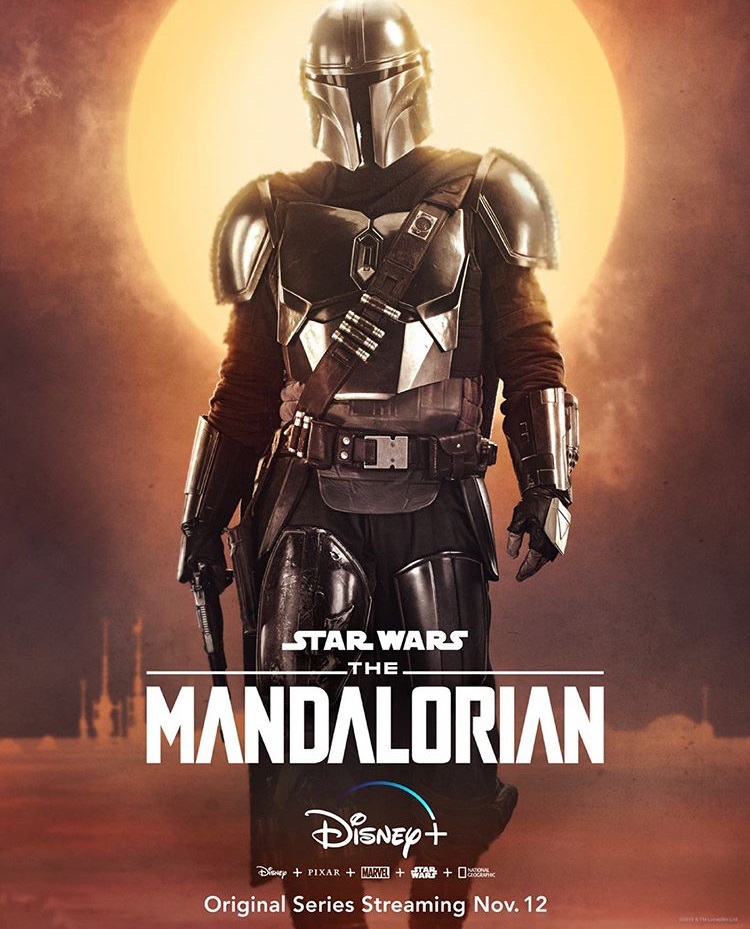A poster for the Star Wars show, The Mandalorian. The show was released on November 12th, 2019 and has released five episodes. (Photo public domain)
With the release of Disney’s streaming service, Disney+, came the first episode of Star Wars’ The Mandalorian. The first live action TV series from the franchise, the show follows its titular character, the Mandalorian, and focuses on his journey as a bounty hunter. As of now, the first five episodes are out and the show is being praised as phenomenal. Spoiler warning if you haven’t seen the episodes from here on out.
The Mandalorian has no name. The masked, bounty hunting main character is rarely referred to as anything other than “The Mandalorian”, even though that’s technically the name of his species, too. They all wear helmets, and the Mandalorian’s has yet to come off, meaning the show’s protagonist has no face either. Somehow, though, The Mandalorian makes it work.
The opening episode quickly establishes the bounty hunter’s character, and by quickly, I mean he beats up and/or squashes an entire bar full of thugs before the episode even hits the three minute mark. It’s an entertaining opening, but if any show defined its protagonist as nothing more than punching and shooting, it wouldn’t make for a very good show.
The character and set design within the first five minutes is already gorgeous. The Mandalorian’s T-shaped helmet and human form never feels out of place with a bright blue fish-man or an alien with tentacles coming out of his face; but then again, that’s Star Wars. Dating all the way back to George Lucas’ original film trilogy, the franchise has distinguished itself using beautiful and unique character design, and The Mandalorian is no different.
If the Mandalorian himself is meant to scare the audience a little, the show succeeds. In response to a bribe, The Mandalorian utters a menacing “I can bring you in warm… or I can bring you in cold,” echoing the “dead or alive” trope of classic Westerns. If any genre is analogous to the feel of The Mandalorian, it’s old Westerns– and the tone is completely intentional. The show’s creator, Jon Favreau, has even said he was inspired by old cowboy flicks. The Mandalorian’s entrance in the bar is a not-so-subtle nod to the iconic “newbie walks into a bar” trope, and a singular shot of the bounty hunter (followed by his prey) establishes the character as a lone gunslinger type.
The rest of “Chapter One” is spent establishing this character. The Mandalorian is a part of The Guild, an organization that’s nothing compared to the looming Empire or Republic, but still menacing in their own right. This is one of the refreshing things about the show. While the blockbuster movies focus on massive plot lines and saving the galaxy, The Mandalorian is small-scale and therefore entertaining in a different way.
After getting his first mission– to retrieve an anonymous package for the villainous Empire– the Mandalorian needs help from a little orange alien naed Kuiil. This is where The Mandalorian differs from other lone gunslinger-type adventure stories– not only does The Mandalorian accept his help, he does so readily and with gratitude. Sure, he’s a bit brooding and can seem closed off, but he’s not stubborn. The Mandalorian is smart.
Once he gets to his target, The Mandalorian meets a bounty droid and promptly gets into a firefight with some locals. Viewers quickly learn the show’s protagonist has a knack for trouble, and the scene in which he and IG-11 (the first droid to be introduced in the show) get shot at for five minutes simply emphasizes the point. Of course, they make it out of the situation, because, of course, two people can fight off fifty aliens without a scratch. IG-11 and The Mandalorian have both been sent to capture the asset by the Empire but the asset is… a child? And so, Baby Yoda is introduced.
To clarify, Baby Yoda is technically neither a baby nor Yoda. He’s 50, and of the same unnamed species as Yoda, but at this point in the Star Wars franchise, Yoda is dead. Who cares about that, though? He’s the cutest thing ever! Baby Yoda deserves his own entire article, but it’s important to mention that the tiny green alien instantly took the internet by storm. The show technically never names him, only calling him “The Child” or “The Asset”. Fans dubbed him Baby Yoda, though, and instantly formed a connection; the Mandalorian is evidently no different.
The Mandalorian is popular with fans for a reason. As mentioned earlier, a darker, lone character that readily accepts help is not the norm (especially as a male) and it’s a nice change from the brooding, “I only work alone” types of past stories. Also, possibly more subliminally, the titular character forms connections well. First with Kuiil and then with Baby Yoda, the Mandalorian easily connects with characters when they’re genuinely good people, but can make clear distinctions between those and those that aren’t. The blue fish alien and IG-11 are just some examples of the Mandalorian’s trust (or lack thereof), and therefore intelligence.
Chapter Two is mostly filler, but features some great moments, including a scene that demonstrates the connection already formed between Baby Yoda and the Mandalorian. Just like his predecessor, the (slightly) larger Yoda, the Child has an affinity with the Force! In case you’ve been living under a rock your entire life, the Force is Star Wars’ version of magic– a mysterious power that allows users to control things with their mind. Just as the Mandalorian is about to be sent to the Mandalorian castle in the sky, Baby Yoda stops the beast attacking him in its tracks using the Force; it’s a cool moment accompanied by an anticipating crescendo of music.
The Force is one of The Mandalorian’s first glimpses at the larger aspects of Star Wars. As mentioned earlier, the show is small-scale, allowing moments that would be otherwise wasted in big films to be exceptionally powerful.
The Mandalorian suffers from a filler problem. One could even argue that the episodes aren’t linked, but there’s enough semblance of a story that it’s confusing when not many of the episodes further the plot. Somehow, though, it never loses its quality. The visuals in the second episode are arguably better than the first and what it lacks in any meaningful character development it makes up for in entertaining action.
Chapter Three of The Mandalorian gets back to what the fans really want: Baby Yoda content. Beyond being amazingly cute, the father-son dynamic between the two main characters is one of the best parts of the show. Which is why it breaks every viewer’s heart when the Mandalorian seemingly gives the asset back to the bad guys.
There’s no time to dwell on it, though, as the episode quickly transitions to another part of the Mandalorian’s story– his species. The show itself gives background on the race of humanoids through nuggets of dialogue, but offers disappointingly little of it. Apparently, they’ve been driven underground because of the Empire, the very organization that the Mandalorian is conversing with. This leads to a scuffle with some of the Mandalorians; some clearly want him to stop. This brief section of the show is great for establishing the Mandalorian’s character. Showing that characters have weaknesses is important, and the Mandalorian being intimidated by his clan is a great way of doing it.
The show is seemingly at its beginning again. The bounty hunter gets his next job, purposeless and alone, and flips on his ship, only to pause. The best acting in the show is easily that of the Mandalorian’s, played by Pedro Pascal. He never takes off his mask, yet somehow conveys every emotion he feels– including those that have come of giving up Baby Yoda– through physical and voice acting. Viewers feel the feelings he does; there’s no giving up on Baby Yoda. The Mandalorian expertly yet subtly makes the audience attached to both characters, and bringing them together and ripping them apart highlights the brilliant bond between bounty hunter and child.
The rest of the episode is a beautiful mashup of action scenes and tense standoffs. The Mandalorian manages to take down an entire squadron of stormtroopers, and after getting stuck in a shootout, the Mandalorians show up! Getting help from his fellow Mandalorians is yet another example of the titular character’s ability to form connections despite conflict, and not one second of the episode feels wasteful or out of place.
There’s genuinely not much to talk about in episode four. A throwaway plot in which the Mandalorian helps the farmers defeat an Imperial machine is made no better by a confusing romance between the head female farmer and the Mandalorian that goes nowhere. The only good part of the episode is the introduction of a new character — Cara Dune, a mysterious soldier hiding out on Sorgan. The two characters team up with each other and then with the farmers.
The fourth installment in The Mandalorian is pretty much a waste of an episode that could’ve furthered the plot line. The biggest negative about the show, unfortunately, is that it doesn’t HAVE much of a plot line. Taking care of The Child has been the only thing linking episodes, and Chapter Four doesn’t do much with him. On to episode five.
The most recent installment of The Mandalorian changes the scenery of the show almost as much as it’s predecessor. The Mandalorian himself starts off in a firefight with an enemy ship, shooting him down but damaging his own ship in the process. He makes an emergency landing on a planet most viewers will recognize– Tatooine. This is arguably the biggest of the callbacks to past Star Wars that The Mandalorian has made, a pretty large nod to the original film. The show steadily introduces new characters over time, but keeps very few of them– a fellow bounty hunter named Toro and their prey Fennec Shand are both dead by the end of the episode.
The Mandalorian’s lack of attachment to its settings and characters could be seen as either a positive or a negative. On the plus side, viewers get new content every week without extending a tired storyline. On the contrary, likeable characters never stay around and any threats don’t feel very threatening. The show’s one-episode story chunks somehow work, though. Every single one is an entertaining mini story with its own plot and faults, but those faults don’t distract from the quality of the show. The Mandalorian is a beautiful love letter to the Star Wars universe that, with all its shortcomings, manages to maintain the core of the main character and earns every bit of praise it receives.

Hi! My name is Brendan Shore and I am a staff writer for The Mycenaean. I am an avid photographer and rock climber!

Leave a Reply